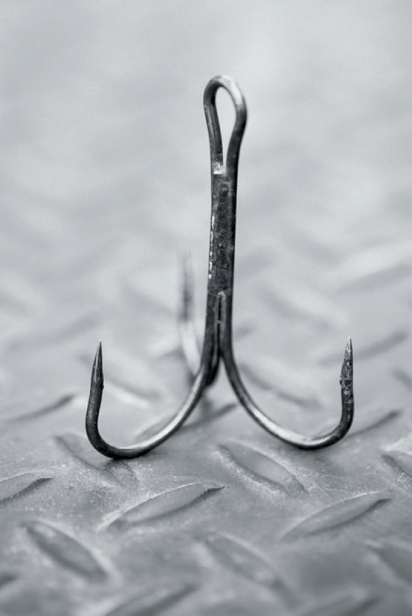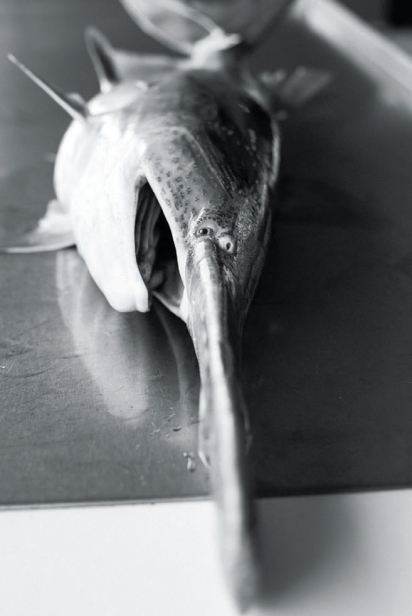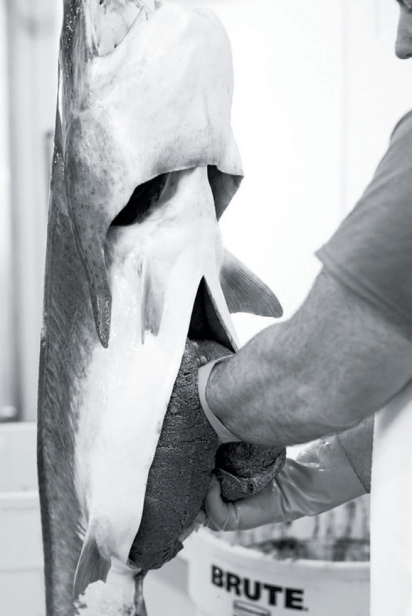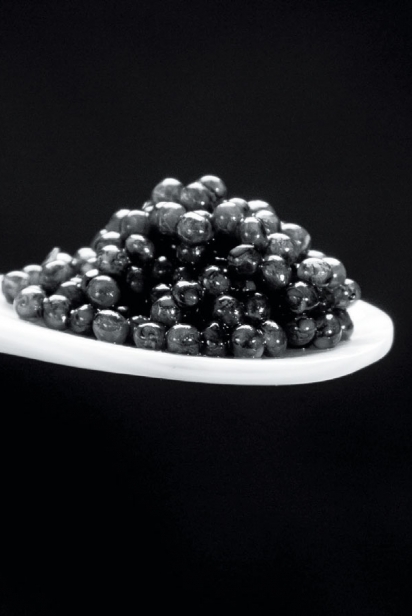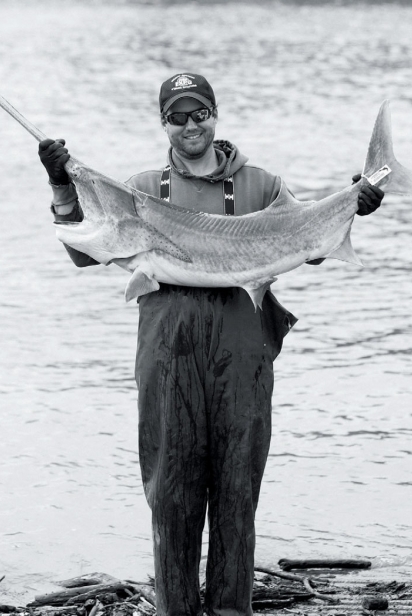Big Fish
Oklahoma Paddlefish Caviar
The story of Polyodon spathula is a curious one indeed.
Like many good stories it involves men of immeasureable grit, battling massive beasts of burden for either sheer sport, money, food, or science. It is a story of family honor, Russian fishmongers, and of a creature so prehistoric that it saw the dinosaurs appear and vanish.
Commonly known as the American paddlefish, Polyodon spathula makes its home in the lakes and rivers of northeastern Oklahoma and has for some 300 million years.
Each spring, when the waters are right, the fish instinctively move from lakes like Grand, Hudson, and Ft. Gibson, up tributaries like the Neosho and Spring, to spawn. This annual migration of paddlefish has attracted anglers for decades from around the country to the town of Miami in hopes of snagging a prehistoric beast that can weigh upwards of 100 pounds. Females can harbor several pounds of eggs called roe, highly prized both nationally and worldwide, as a substitute for the endangered beluga sturgeon caviar.
Growing interests in legal paddlefishing for sport matched with increased activity in paddlefish caviar smuggling exposed a need for the Oklahoma Department of Wildlife Conservation (ODWC) to get a better handle on sustainably managing the spoonbill population; thus, the Paddlefish Research Center (PRC) was established southeast of Miami near Twin Bridges State Park.
Today the center is a hub of activity, collecting data on thousands of paddlefish each spring. Sport fishers voluntarily bring legally harvested spoonbills to the sparkling facility where they are meticulously screened for biological data. In exchange for the data, the fish are cleaned and filleted, packaged, and given back to the angler free of charge.
It’s what the anglers aren’t given back at the PRC that has heads turning.
Roe is in the Wishard family’s blood.
Riely Wishard, who grew up an orphan in Pryor in the 1930’s, began commercially fishing for paddlefish with sons Billy Ray and Roger, in the waters near their Chouteau, Oklahoma home in the 1970s. Together, the Wishards spent years plying the waters of northeastern Oklahoma, in search of spoonbill to harvest for caviar with the results of their catches eventually landing in Russia.
Amber Williams learned the family methods of caviar production from her father Billy and is one of only a handful of people in the state who knows how to properly screen and grade caviar. “Our family grew up on the water,” she says. “We grew up fishing. We grew up spending time together processing fish. Those were all memories made for us.”
In 2008, Billy Ray helped the PRC set up its caviar processing operation using knowledge and techniques gleaned from years spent producing caviar with his dad and brother.
“Now that our grandpa passed away and our father passed away, it’s an honor for us to be able to carry this on and be able to pass it on to our kids just like it was passed down to us” says Crystal Johnson. Her son Austin is the fourth generation of Wishards to have his hands in Oklahoma caviar production.
Today Williams, along with her sister, Crystal, and brother, Billy Jr., own and operate Wishard Caviar Consulting and are contracted by the Paddlefish Research Center to process and package highly valuable roe from paddlefish that are donated to the Department of Wildlife for research. It’s a symbiotic relationship that has sustained itself for eight years now.
While commercial fishing for the paddlefish in years past was legal (banned statewide in 1993), the legality in the trade of spoonbill byproducts seemed to be a bit blurry.
Little was known about the paddlefish then and few fishers seemed to care. Most anglers who snagged a spoonbill in the early days would harvest the meat to fry up at home, and toss the eggs back into the water, potentially thousands of dollars worth per fish. Creel limits were liberal and the season length was long. Those who did salvage the eggs often took them home to feed to pets or pigs or to use as fish bait, a fancy feast indeed.
Intrepid anglers opted to trade processed caviar domestically, with most international sales winding up in Russia via New York City. The spring paddlefish run in Oklahoma often brought with it (and still does today) Eastern European expats and nationals alike, scouring the bank of the Neosho and Grand rivers, on the hunt for caviar that could be exported overseas to supplement a dwindling Russian supply, by means both licit and illicit.
Currently in the state of Oklahoma it is legal to be in possession of up to three pounds of paddlefish for personal consumption. All sales or trading of the fish and its eggs are strictly prohibited and subject to hefty fines and jail time.
Increasing activity from local anglers in the sport of paddlefishing resulted in rising harvest numbers annually. A declining supply of the highly prized beluga sturgeon caviar from the Caspian Sea in Russia and Iran boosted international demand and prices for U.S. stock soared.
The American paddlefish is widely believed to be the oldest living animal or fish species in North America. Its closest familial relative, the Chinese paddlefish—native to the Yangtze River in China—hasn’t been seen alive since 2007, making it critically endangered.
Brandon Brown, supervisor of the Paddlefish Research Center, is the man weighted with the responsibility of making sure that Oklahoma’s most valuable fish doesn’t go the way of its Chinese brethren.
“To really do the work we needed to do to manage this population, we’ve needed two things: data and manpower, and this program has provided both of those things,” says Brown. “Now we are getting data from 3,000 fish a year and the beauty of that is that we didn’t have to kill any fish to do it.”
Brown admits that when the program was first started in 2008 that the overall state of the Oklahoma spoonbill was “unknown.” The ODWC knew there were large numbers of the fish but they didn’t know much about their lifespan or spawning tendencies and the species wasn’t being managed very closely. Poaching and illegal caviar harvesting were also issues. The first several years yielded huge amounts of data from the paddlefish and management changes were made quickly and accordingly.
Creel limits for paddlefish anglers changed to greatly reduce the overall number of fish being harvested. The ODWC also shortened the fishing season, including catch and release only on certain days. They even closed popular fishing locations altogether, creating paddlefish “sanctuaries.” Today, Oklahoma boasts what could likely be called the world’s best paddlefish fishery, drawing thousands of out of state visitors to northeastern Oklahoma waterways every spring from March through April, an incredible fiscal boom for area businesses.
There has been a recent sea change of sorts in the world caviar market.
Historically, caviar comes only from beluga sturgeon, which are native to the Caspian and Black Seas. They are also the largest freshwater fish species in the world, with adults weighing over 2000 pounds, exceeding ten feet in length. However, because of over-fishing, poaching, and increased habitat loss, they are listed as an endangered species with major concerns about the future of the world’s most valuable fish.
In 2005, the U.S. banned all imports of beluga sturgeon, prompting local and international buyers searching for more sustainable caviar sources to fuel an increasing demand both domestically and internationally.
The Paddlefish Research Center in Miami has had the attention of Chuck Barnes for about a year now.
Barnes is president of Fog City Trading Company—a San Francisco Bay Area based sustainable seafood wholesaler and marketing firm. When Oklahoma Spoonbill caviar hits the market this spring Barnes hopes to replenish his stock.
“Customers are demanding that their seafood be sustainable,” says Barnes. “We wanted to give our customers the choice to buy sustainable paddlefish caviar versus paddlefish caviar that may not be.” He adds that Oklahoma is in a unique and highly marketable situation with its caviar production process—it’s wild-caught instead of farm-raised, which chefs and general consumers find preferable. It’s also sustainable, traceable, and verified, with each tin sold containing a number that can be tracked back to the fisherman who caught the fish and to the individual who processed the caviar at Oklahoma’s Paddlefish Research Center.
Barnes continues: “The Oklahoma paddlefish caviar seems to have more positive notes all the way through. It looks good, it tastes good, and has a good fish flavor. Traceability is important to show [consumers] that producers are doing what they claim they are doing. It’s a big world and Oklahoma is just one cog in that [caviar] machine… but the Oklahoma story is pretty much the best story in my opinion. When you see something like what’s happening in Oklahoma—it’s highly unusual but definitely good to see.”
Oklahoma caviar produced by the PRC is auctioned off to the highest bidder via a closed Internet auction. Lots are set at a minimum of 1,000 pounds. To ensure caviar doesn’t wind up in the hands of ne’erdo- wells, all bidders undergo rigorous background checks. The biggest buyers are the Japanese, with large amounts also winding up in Europe. About a third of the 2014 stock stayed within the United States, a number that is growing. All proceeds from the sales (to the tune of $1.5 million in 2013) are channeled back into the ODWC to help fund a variety of programs throughout the department including wildlife law enforcement and research of other animals, unrelated to the paddlefish.
“We could be having an effect on paddlefish populations in other states, challenging other states to manage sustainably as well,” says Brandon Brown. The addition to Oklahoma caviar on world markets has driven down prices for black-market paddlefish caviar, making it a less profitable option for outlaws.
The beauty in all of this is that the paddlefish are essentially saving themselves, through research and egg harvesting, while preserving a decades-old way of life for one Oklahoma family. Less than ten years ago, we knew precious little about a fish that was on the verge of possible extinction. This has now become a model in sustainability for fish species in other states, while simultaneously derailing the bad guys who sought to destroy them.



